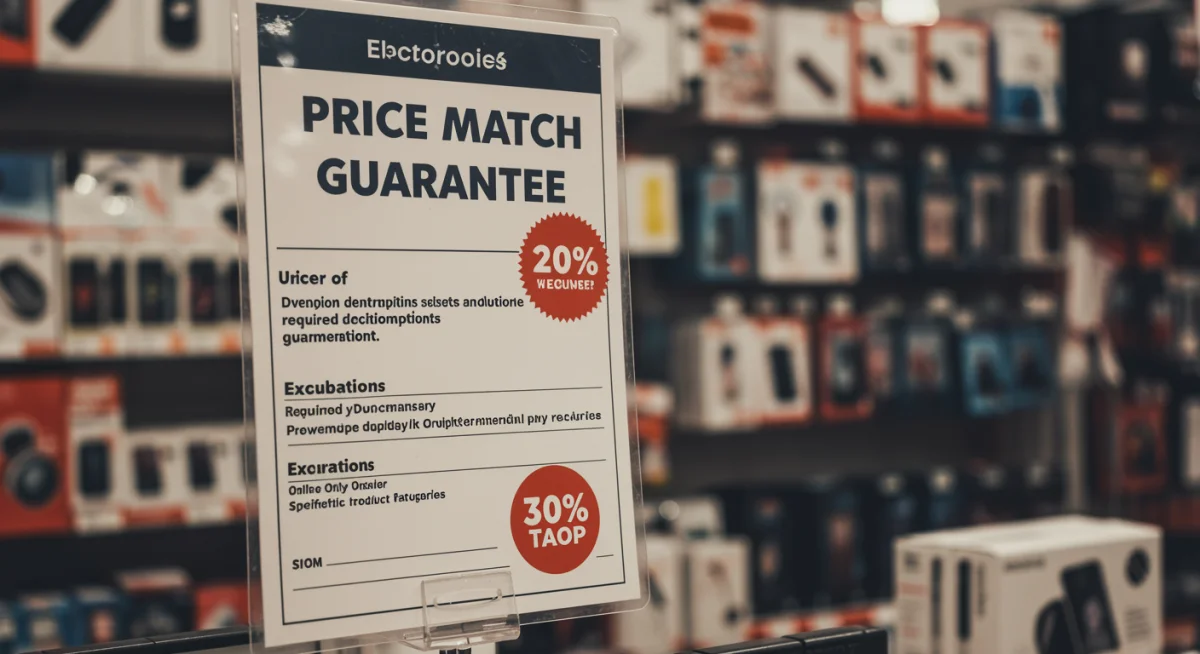Effective Price Matching Strategies for 2025: Save on Big-Ticket Items

Mastering price matching strategies in 2025 can help consumers secure substantial savings, particularly on big-ticket items, by understanding retailer policies and effectively comparing prices to guarantee the best deals.
In today’s competitive retail landscape, securing the best deal often feels like a game of strategy. One of the most potent tools in a savvy shopper’s arsenal is the art of price matching. By understanding and implementing effective strategies for utilizing price matching guarantees in 2025: save up to 30% on big-ticket items, you can significantly reduce your expenditures on everything from electronics to appliances and furniture. This guide will walk you through the nuances of these policies, helping you become a master of saving.
Understanding the fundamentals of price matching policies
Price matching policies are not uniform across all retailers. Each store sets its own rules, limitations, and requirements, which can often be a source of confusion for consumers. Before attempting to price match, it is crucial to thoroughly review the specific policy of the store you intend to purchase from. This foundational understanding is the first step toward successful savings.
Many retailers offer a price match guarantee as a way to remain competitive and retain customer loyalty. They understand that consumers are increasingly price-sensitive and will shop around to find the lowest cost. By offering to match a competitor’s price, stores aim to prevent customers from taking their business elsewhere, ensuring a sale while still providing value.
Key elements of price matching policies
When examining a retailer’s price matching policy, several common elements typically stand out. Knowing what to look for can streamline your process and prevent frustration at the checkout counter.
- Competitor criteria: Most policies specify which competitors they will match. This often includes local brick-and-mortar stores or major online retailers, but rarely smaller, independent shops or auction sites.
- Product identicality: The item must be exactly the same – same brand, model number, color, size, and condition. Any slight variation can invalidate a price match request.
- Proof of lower price: You will almost always need to provide evidence of the lower price. This could be a printed ad, a competitor’s website displayed on your phone, or an official quote.
- Exclusions: Be aware of what is excluded. This often includes clearance items, doorbuster sales, refurbished products, or prices from third-party sellers on marketplaces.
Furthermore, some policies have time limits. For instance, a store might offer a price match within 7, 14, or even 30 days of your purchase. This means if the price drops after you’ve bought an item, you can still get a refund for the difference. It’s a valuable detail to remember, especially for expensive purchases where prices can fluctuate.
In conclusion, a deep dive into each retailer’s specific price matching policy is non-negotiable. This initial research will save you time and effort, setting the stage for successful negotiations and significant savings on your big-ticket purchases.
Identifying eligible big-ticket items for price matching
Not all purchases are created equal when it comes to price matching. While theoretically, any item with a competitor’s lower price could be eligible, focusing on big-ticket items yields the most substantial savings. These are the purchases where a 10-20% discount can translate into hundreds, if not thousands, of dollars saved.
Big-ticket items typically include electronics like televisions, laptops, and home theater systems; major appliances such as refrigerators, washing machines, and ovens; and furniture sets. These categories are often characterized by high price points and frequent promotional cycles, making them prime candidates for price matching opportunities.
Prioritizing high-value purchases
To maximize your savings, it’s wise to prioritize items where the price difference can significantly impact your budget. A $5 saving on a small item is good, but a $200 saving on a new refrigerator is transformative. This strategic focus ensures your efforts are directed where they matter most.
- Electronics: Look for deals on the latest smartphones, smart TVs, gaming consoles, and computers. Prices for these items are highly volatile, and competitors often try to undercut each other.
- Major appliances: Refrigerators, dishwashers, ovens, and laundry machines are perfect for price matching. These items are often sold by multiple large retailers, increasing the chances of finding a lower price elsewhere.
- Furniture: For large furniture pieces or sets, price matching can lead to considerable savings. Many furniture stores compete fiercely, especially online.
- Home improvement materials: Large purchases for renovations, such as flooring, cabinetry, or major tools, can also be excellent candidates for price matching.
Before committing to a purchase, take the time to research prices from various reputable retailers. Online comparison tools and apps can be incredibly helpful in this regard, automating much of the legwork. Remember that some retailers might only match prices from competitors within a certain geographical radius, so local competitor ads are still relevant.
The key takeaway here is to be discerning with your efforts. While price matching can be applied broadly, its true power is unleashed when applied to purchases that genuinely move the needle on your personal finances. Focus on those substantial expenditures to realize the most impactful savings.
Mastering the art of price comparison and documentation
Once you understand the policies and have identified your target big-ticket item, the next critical step is mastering price comparison and meticulous documentation. This involves more than just finding a lower price; it means presenting that information in a way that leaves no room for doubt or refusal from the retailer.
Effective price comparison requires a systematic approach. It’s not enough to glance at a few websites; you need to delve deeper, checking all relevant parameters to ensure a true apples-to-apples comparison. This precision is what often makes or breaks a price match request.
Tools and techniques for accurate price comparison
The digital age offers a plethora of tools to aid in price comparison. Leveraging these can significantly enhance your efficiency and accuracy.
- Price comparison websites: Sites like Google Shopping, PriceGrabber, and Shopzilla aggregate prices from various retailers, making it easy to see who offers the lowest price for a specific product.
- Retailer apps: Many major retailers have their own apps that include price comparison features, sometimes even allowing you to scan barcodes in-store to check competitor prices.
- Browser extensions: Extensions like Honey or CamelCamelCamel automatically track price drops and compare prices as you browse e-commerce sites, offering real-time insights.
- Direct competitor websites: Always check the websites of direct competitors. Sometimes, the best deals aren’t widely advertised but are available directly on their product pages.
Beyond just finding the price, pay close attention to the product’s exact specifications. Model numbers are paramount. Even a single digit difference can mean a different version of the product, which might not be eligible for price matching. Confirm colors, sizes, and any included accessories or bundles. If the competitor’s price includes shipping or a special offer, factor that into your comparison.

Documenting your findings
Proper documentation is your evidence. Without it, your price match request is merely a claim. Most retailers require tangible proof of the lower price.
- Printed advertisements: If you find a lower price in a local flyer or newspaper ad, bring the physical ad with you.
- Screenshots: For online prices, take clear screenshots that include the product, the price, the retailer’s name, the date, and the product’s model number. Ensure the URL is visible.
- Live website display: Some stores allow you to show the live competitor’s website on your smartphone or a store computer. Be prepared to navigate quickly to the product page.
- Email offers: If you received a personalized offer via email from a competitor, print it out or have it ready to display.
Always double-check that the competitor’s price is current and in stock. A price match won’t be honored if the item is out of stock or the promotion has expired. Having all your ducks in a row makes the process smooth and increases your chances of success, leading to those significant savings you’re aiming for.
Strategic timing and approach for maximum savings
Timing can be everything when it comes to price matching. Knowing when to look for deals and how to approach retailers can significantly impact your success rate and the amount you save. It’s not just about finding a lower price, but also about presenting your case effectively.
Retail cycles often dictate when the best deals emerge. Understanding these patterns allows you to anticipate price drops and prepare your price match requests in advance, positioning you for optimal savings on big-ticket items. This proactive approach sets apart the casual shopper from the seasoned savings expert.
Optimal times to seek price matches
Certain periods of the year are more conducive to finding lower prices and, consequently, successful price matching.
- Holiday sales events: Black Friday, Cyber Monday, Amazon Prime Day, and other major holidays are prime times for deep discounts. Competitors often try to match or beat these prices, creating numerous opportunities.
- Seasonal clearances: As new models are introduced, older models of electronics and appliances go on clearance. This can lead to significant price drops that can be matched.
- End-of-month or end-of-quarter sales: Some retailers push to meet sales targets at these times, leading to aggressive pricing.
- New product releases: When a new version of a product is released, the price of its predecessor often drops.
Beyond specific dates, keep an eye on competitor advertisements throughout the week. Many stores release their weekly ads on Sundays or Mondays, and these are excellent sources for current lower prices. If a store offers a post-purchase price match guarantee, make sure to check prices regularly within that window after your purchase.
Approaching the retailer
How you present your price match request can influence the outcome. A polite, clear, and prepared approach typically yields the best results.
- Be prepared: Have all your documentation ready and easily accessible. Know the exact model number and the competitor’s price.
- Know the policy: Be familiar with the store’s specific price match policy. This helps you address any questions or objections confidently.
- Be polite and patient: Retail employees are more likely to help a courteous customer. If there’s a delay or a policy check, remain patient.
- Ask for a manager: If a sales associate is unsure or refuses without a clear policy reason, politely ask to speak with a manager. They often have more leeway.
- Match in-store: While some retailers offer online price matching, doing it in-store often allows for quicker verification and resolution.
The goal is to make the process as straightforward as possible for the employee assisting you. By being organized and respectful, you increase your chances of walking away with a great deal and the satisfaction of knowing you’ve maximized your savings.
Navigating common pitfalls and exclusions
While price matching offers incredible saving potential, it’s not without its challenges. Understanding common pitfalls and exclusions can help you avoid disappointment and ensure your efforts are well-placed. Many consumers encounter obstacles not because the policy is unfair, but because they haven’t fully grasped its limitations.
Retailers design their price matching policies to protect their profit margins while still offering a competitive edge. This means there are often specific scenarios or types of deals they will not match. Being aware of these exceptions beforehand is crucial for a smooth price matching experience.
Typical exclusions to watch out for
The devil is often in the details when it comes to exclusions. These are some of the most frequently encountered limitations:
- Third-party marketplace sellers: Prices from Amazon, eBay, or Walmart Marketplace sellers (not directly from Amazon, Walmart, etc.) are almost never matched.
- Limited-quantity sales: “Doorbuster” or “limited-quantity” deals are typically excluded because they are designed to drive traffic and are not sustainable long-term prices.
- Clearance, liquidation, or open-box items: These are often unique situations where the price is already significantly reduced, making further matching impractical for the retailer.
- Typographical errors: If a competitor’s ad or website clearly has a pricing mistake, retailers are unlikely to honor it.
- Bundle offers or promotions with free items: Policies usually state they will only match the price of the individual item, not complex bundles or offers that include free accessories.
- Prices requiring membership: Warehouse club prices (e.g., Costco, Sam’s Club) or prices requiring a specific loyalty program membership might be excluded.
It’s also important to note that some retailers have different online and in-store pricing policies. An online-only deal from a competitor might not be matched in a physical store, and vice-versa. Always check if the policy specifies matching online-only offers or only local brick-and-mortar competitors.
Avoiding common mistakes
Beyond exclusions, certain mistakes by shoppers can lead to a denied price match.
- Incorrect product identification: As mentioned, even a slight difference in model number can invalidate a match. Double-check every detail.
- Expired offers: Presenting an ad or online price that has already expired is a common oversight. Ensure the offer is current.
- Not having proof: Relying on memory or a vague description of a deal will not suffice. Always have verifiable proof.
- Assuming universal policies: Never assume one store’s policy applies to another. Always review each retailer’s specific rules.
By being diligent in your research and understanding the nuances of price matching, you can confidently navigate these potential pitfalls. This preparedness transforms a potentially frustrating experience into a rewarding one, securing the savings you deserve on your significant purchases.
Leveraging technology and apps for seamless price matching in 2025
The landscape of retail is constantly evolving, and 2025 sees an even greater reliance on technology to enhance the shopping experience. For price matching, this means a wealth of apps and digital tools that can streamline the process, making it easier than ever to find and secure the best deals on big-ticket items.
Gone are the days when price comparison meant flipping through dozens of newspaper ads. Today, your smartphone can be your most powerful ally, transforming minutes of tedious research into mere seconds of automated comparison. Embracing these technological advancements is key to maximizing your price matching success.
Essential apps and platforms for price comparison
A variety of applications and online platforms have emerged, specifically designed to help consumers track prices and identify matching opportunities efficiently.
- Dedicated price comparison apps: Apps like ShopSavvy, BuyVia, and RedLaser (though some have evolved or merged) allow you to scan product barcodes in-store and instantly compare prices across multiple online and local retailers.
- Retailer-specific apps: Many major retailers (e.g., Best Buy, Target, Walmart) have their own apps that often include price comparison tools, sometimes even allowing you to initiate a price match request directly through the app.
- Browser extensions and add-ons: Tools like Honey, CamelCamelCamel (for Amazon), and Keepa track historical price data and notify you of price drops, which is invaluable for post-purchase price adjustments.
- Google Shopping: Google’s own shopping platform aggregates product listings and prices from countless online stores, offering a comprehensive overview of the market.
These tools not only help you find the lowest price but also provide historical data, allowing you to discern whether a current “deal” is truly a good value or if the price is likely to drop further. This intelligence is particularly valuable for big-ticket items, where waiting for the right moment can save you hundreds.
Tips for effective digital price matching
While technology automates much of the work, a few best practices can further enhance your digital price matching strategy.
- Set price alerts: Many apps and websites allow you to set alerts for specific products. You’ll receive a notification if the price drops below a certain threshold, making it easy to jump on a deal.
- Organize your findings: Use a spreadsheet or a dedicated note-taking app to keep track of competitor prices, model numbers, dates, and the retailer’s price match policy details.
- Verify in-stock status: Before heading to the store or contacting customer service, always confirm that the lower-priced item is in stock at the competitor.
- Screenshot everything: Even if you plan to show a live website, a screenshot serves as a backup in case the price changes or the website goes down.
By integrating these technological tools and practices into your shopping routine, price matching becomes a seamless and highly effective way to ensure you’re always paying the lowest possible price for your significant purchases. The future of smart shopping is here, and it’s powered by intelligent use of digital resources.
Case studies and success stories: real-world savings
The theory behind price matching is compelling, but real-world examples truly underscore its power. Examining various case studies and success stories reveals how everyday shoppers have leveraged price matching policies to achieve substantial savings on big-ticket items, turning potential frustrations into significant financial wins.
These anecdotes not only inspire but also provide actionable insights into how different policies can be navigated and maximized. They demonstrate that with a bit of research and a confident approach, anyone can become proficient at securing the best possible price for their desired purchases.
Electronics savings: the new TV dilemma
Consider Sarah, who wanted to buy a new 65-inch 4K smart TV. She found the TV at her local electronics store for $1,200. Before purchasing, she checked online and discovered a major online retailer selling the exact same model for $1,050. Knowing her local store had a price match guarantee, she printed out the online listing, including the model number and in-stock status.
- Action: Sarah approached the customer service desk with her printed proof.
- Outcome: After a quick verification, the store matched the online price, saving her $150 instantly.
- Lesson: Even a seemingly small percentage difference on a high-value item translates to significant dollar savings.
In another instance, John purchased a new laptop during a pre-holiday sale for $900. Two weeks later, a competitor announced a flash sale on the identical laptop for $750. Remembering the 30-day post-purchase price adjustment policy of his original store, John contacted customer service.
- Action: John provided the sales associate with a screenshot of the competitor’s current ad.
- Outcome: The store issued him a $150 refund to match the lower price.
- Lesson: Always be aware of post-purchase price adjustment policies, especially during volatile sales periods.
Appliance bargains: kitchen renovation success
Maria was renovating her kitchen and needed a new stainless steel refrigerator. Her preferred appliance store quoted her $2,500. She then found the same model at a different local big-box store’s weekly ad for $2,200.
- Action: Maria brought the competitor’s weekly ad to her preferred store.
- Outcome: The store honored the price match, saving her $300, and she still got to purchase from the store she trusted for delivery and installation.
- Lesson: Local store ads are powerful tools for price matching, and you don’t have to compromise on preferred service providers.
These stories illustrate that price matching is not just a theoretical concept but a practical, effective strategy for significant savings. By applying the knowledge of policies, diligent comparison, and a confident approach, consumers can consistently achieve better deals on their important purchases.
| Key Aspect | Brief Description |
|---|---|
| Policy Understanding | Thoroughly review each retailer’s specific price match rules, exclusions, and accepted competitors. |
| Item Eligibility | Focus on big-ticket items (electronics, appliances, furniture) for maximum savings impact. |
| Documentation & Tools | Use apps/websites for comparison; provide clear proof (screenshots, ads) of lower prices. |
| Strategic Timing | Leverage sales events and post-purchase windows; approach retailers politely and prepared. |
Frequently asked questions about price matching
A price matching guarantee is a policy offered by retailers to match a competitor’s lower price for an identical item. This strategy helps stores retain customers and remain competitive, ensuring you get the best deal without having to shop at multiple locations.
Big-ticket items such as electronics (TVs, laptops), major appliances (refrigerators, washing machines), and furniture are ideal for price matching. The higher cost of these items means even a small percentage discount can result in significant dollar savings.
Retailers typically require verifiable proof of a lower price. This can include a printed advertisement, a live display of a competitor’s website on your smartphone, or a clear screenshot showing the product, price, retailer, date, and model number.
Many retailers offer a post-purchase price adjustment period, usually ranging from 7 to 30 days after your purchase. If the price drops or a competitor offers a lower price within this window, you can request a refund for the difference.
Yes, common exclusions include prices from third-party marketplace sellers, limited-quantity sales, clearance items, typographical errors, bundle offers, and prices requiring membership. Always check the specific retailer’s policy for full details.
Conclusion
Mastering the art of price matching in 2025 is more than just a shopping hack; it’s a strategic approach to consumer spending that can lead to substantial savings, particularly on big-ticket items. By diligently researching retailer policies, utilizing modern price comparison tools, meticulously documenting lower prices, and approaching stores with confidence and preparedness, shoppers can consistently secure the best deals. The effort invested in understanding these strategies pays off, transforming the way you purchase everything from new electronics to essential home appliances, ensuring you keep more money in your pocket.





